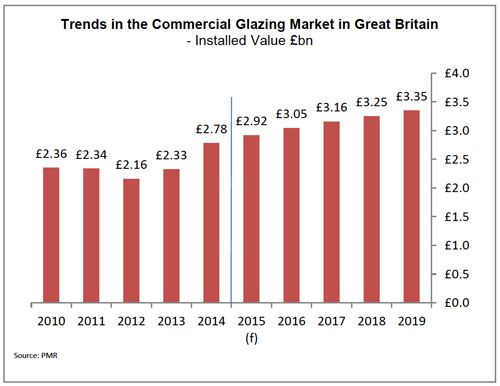
 Following two years of growth in the commercial glazing market, the picture looks positive to 2019, according to the latest Palmer report.
Following two years of growth in the commercial glazing market, the picture looks positive to 2019, according to the latest Palmer report.
In the previous (2013) report on commercial glazing, PMR director Robert Palmer forecast positive growth for an industry that had actually shrunk 10% in 2012, after three previous years of decline, with several product categories reporting record lows.
The recently published 2015 report shows an increase of 10% in volume terms between 2012 and 2014, with the market expanding in almost all product categories.
Windows, representing over 50% of the total market, showed a 12% volume rise, and only shop fronts showed a decline in volume (of 2%, and this was actually accompanied by a 12% rise in value terms).
The difference in volume and value growth observed in the 2013 report continues. Value growth from 2012 to 2014 is reported at 29%, with all categories showing important increases in average installed value, particularly curtain walling and roof glazing, at 20% and a huge 36% respectively.
Palmer expects a further 20% rise of the market to 2019, as a result of a growing wider economy, as the chart (pictured) shows.
Important growth in two of the four biggest industry sectors for commercial glazing products – commercial offices and apartment blocks – helped to drive the expansion of the last two years. Indeed, it’s unsurprising that curtain walling, with 35% of its market in office buildings, was the fastest growing product (13.4%).
Looking forward, different industry sectors polarise somewhat: glazing products in commercial offices will continue to rocket up by 39% to 2019 as business investment, employment and the wider economy grow, while apartment blocks are looking at overall net growth of just 4%, as new government policies on buying and selling high value properties come into effect. Education is forecast to grow, by 22%, in spite of continuing public sector cuts, thanks to private funding of school and university buildings.
Entrance doors, the second biggest product category, have shown, and will continue to show, growth rather below the market, perhaps due to the fact that this product tends to rely more on slightly less buoyant sectors such as education and retail.
Aluminium continues to be by far the most important frame material, and in fact increased its market share over the time period to 81%. Although aluminium/timber composites showed an even higher, 46%, rise over the two years, at 5% of the market, they don’t look to be troubling the leader any time soon according to Palmer.
The aluminium window market is said to be at a ‘historic level’, and will reportedly reach an all-time high by 2019 of 1.74m frames.
Palmer’s report also looks at the solar shading market, which underperformed the market at 10% value growth over the last two years, but looks set to see 28% growth to 2019 as the benefits of the product become more widely known.
Triple glazing still appears to be a niche product, representing just 4% of the market; and fire resistant glazing, measured for the first time in the 2015 report, even more so for now – just 1.2% of all window and 1.6% of all curtain walling installations.



